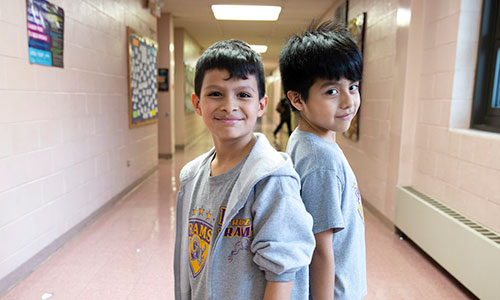
“Shhh.” “Quiet down.” “Please listen.” These are frequent refrains in the classroom as teachers deliver lessons and maintain an orderly environment. Quiet time is indeed an essential part of most school days. There are times, however, when encouraging students to talk is valuable, even essential. The writing process presents especially good opportunities for conversations.
I recall one year when I was teaching fourth grade and reading through students’ first drafts of fictional narratives. One draft that stood out belonged to a student I’ll call Jonathan. It was seemingly a jumble of ideas that didn’t come close to telling a coherent story. I thought Jonathan had either not understood the task or had given it minimal effort, and I was certain that this would come to light when I conferenced with him. I had learned the value of the social classroom and was eager to get Jonathan talking.
Getting students talking
Positive interactions are part of a supportive classroom environment, which is recognized by experts in the field as essential to writing development. Positive interactions during the writing process, between teachers and students or among students, help build a supportive writing environment.
The writing conference between teacher and student in particular can serve as a useful formative assessment tool, helping to reveal areas of strength and needed support, thereby informing instruction. We recognize the value of student discourse as formative assessment. Just as important for the student, though, is the role of the writing conference as a catalyst for reflection. Research supports reflection as a practice for improving not just a particular writing piece but also students’ ability to generalize effective strategies and apply them in the future. What a great reason to get students talking about their writing!
A few months ago, my colleague Julie Richardson introduced us to the Big Ideas for Growing Writers. Framed as five easy-to-remember questions, these Big Ideas are available in a handout for teachers and another for students. (If you haven’t downloaded those yet, please take the time to do so now. They’re free!) The questions are as follows:
- Why am I writing?
- Who are my readers?
- What am I writing?
- How am I presenting my ideas in writing?
- How am I using the writing process?
The Big Ideas are formative conversation starters: they can serve as springboards for conversations with students about their writing and writing process.
What follows are some critical points to consider as you prepare to have these formative conversations with students during whole- or small-group instruction, during one-on-one writing conferences, or with peer feedback groups.
How can I find time for these conversations?
Each formative question in the handouts is designed to take place within a five- to fifteen-minute time frame. You may begin by conferencing with a small group of students while others work independently or with peers.
Once students start to become familiar and comfortable with the process, encourage them to use these questions with one another during peer discussions while you conference with others one-on-one or in small groups. Even a few minutes of one-on-one discussion with the teacher can be impactful for students.
How do I group students?
When creating small groups, use data, such as previous conversations and other formative assessment measures, to group students around specific goals, for example, the goal of considering the needs of the audience or integrating evidence to develop ideas. Groups should be flexible and short term; adjust as students demonstrate progress or the need for more or less intense support.
When creating peer groups, make sure students have clear roles that capitalize on their strengths and that provide opportunities for growth. For instance, students who enjoy playing with language and word use may be grouped together to share ideas and further their repertoire of words and phrases. A student who is writing for a particular audience, such as their peers who enjoy gaming, could grow in audience awareness by conferencing with students who are part of that audience group.
How do I focus the conversations?
The five Big Ideas are designed to provide a measure of focus for each conversation. It will often be necessary, of course, to narrow the conversation further, but avoid the urge to try to address multiple areas of focus in a single conversation. Establish the protocol of brief, focused student conferences for maximum impact.
How do I make peer discussions meaningful?
It’s important to establish practices and expectations for making peer writing conferences effective. Many best practices for assisting peer writing conferences are the same as those you’d likely implement for any type of peer work.
Whether peers are working in small groups or pairs, ensure that everyone knows their role in the conversation and what that role entails. These will include at least one writer and one facilitator, and perhaps a recorder and one or more listeners. Ensure that students rotate roles, of course, but note that they might not need to rotate within every session; it may be more effective and practical to rotate roles on different days.
Ensure that students have the materials they need to support peer conversations. This will likely include the student-friendly version of the Big Ideas linked above. Other resources may include frameworks you’ve developed for capturing feedback, a note-catcher form, general group-work protocols, student-friendly rubrics, and graphic organizers and mnemonic prompts.
How do I prompt reluctant students?
Before initiating writing conversations, it is important to have established a supportive classroom environment, as described above, and to have begun forming positive personal connections with students. Still, you’ll find that some students are eager to talk about their writing process and products, but many will need additional prompting. Be prepared to ask follow-up questions as needed to generate thoughtful dialogue, such as:
- Can you tell me more about that?
- It seems like you’re really thinking about this. What are you thinking?
- How did you arrive at that conclusion?
- Is there another way to approach this goal?
These kinds of follow-up questions are useful for guiding discussions between students as well. Include them in the materials you provide to support peer writing conferences, as they can support both the writer and the listener in generating conversation.
Remember to provide adequate think time to allow students to respond and avoid jumping in with immediate comments and feedback.
In closing
Back in that fourth-grade classroom, I sat with Jonathan for a one-on-one discussion about his narrative. I asked him to explain the story to me, and he launched into a detailed, excited description of the tale he was attempting to tell.
When I realized that he did indeed have a well-developed narrative in his mind, I explained to him that much of the story was in his head but not on paper and that his audience would need more details to be able to follow along. I asked many pointed questions to uncover specific details about the story. A few conversations with Jonathan made a world of difference for him, helping him fill in the missing parts of his story and ultimately end up with a piece he was proud of. He later added illustrations and turned the story into a picture book! I’m glad I was able to get Jonathan talking about his writing.
This school year, don’t forget to ask all your students to speak up!







